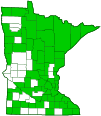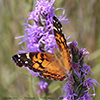American lady
(vanessa virginiensis)
Conservation • Description • Habitat • Ecology • Distribution • Taxonomy
Conservation Status |
|
|||||||
| IUCN Red List | not listed |
|||||||
| NatureServe | N5 - Secure S5B - Secure Breeding |
|||||||
| Minnesota | not listed |
|||||||
Description |
||
American lady is a medium- to large-sized, brushfooted butterfly. It has a wingspan of 1¾″ to 2⅝″. Females are very slightly larger but cannot be distinguished in the field. The summer form is larger and brighter orange, the winter form is paler and has smaller black marks. The outer edge of the forewing is slightly scalloped with an elongated, squared off tip (apex). The upperside of the forewing is orange with an orangish-brown patch at the base; three irregular, black, disconnected, median spots; and a jagged, black, median to postmedian line. The margin has a broad, black border with a row of white, crescent-shaped marks (lunules) and a black and white fringe. The apical area is black with a large, elongated, postmedian, pale orange spot at the leading (costal) edge and a curved row of four smaller, round, submarginal, white spots. Most individuals have a small white spot in the cubital cell. In some individuals the spot is minute or missing. The hindwing is rounded and slightly scalloped with a black-and-white fringe. The upper side of the hindwing is orange with a brownish-orange patch at the base and four bands of black spots: a marginal band of six mostly disconnected spots; a submarginal band of six flattened, mostly connected spots, the inner spot (closest to the body) with a blue center; a postmedian band of four round, often connected spots, usually one or more with blue centers; and a median band of four faint, irregular, more or less connected spots. The underside of the forewing is pinkish-orange near the base and grayish-brown in the apical area, with white and black markings mirroring those on the upper surface. The underside of the hindwing is irregularly banded and mottled at the base with light and dark brown edged with white. There is a broad, pale, median band and a broader, brown, postmedian band. In the postmedian band there are two large, brown eyespots with black borders and blue centers. There is a submarginal row of eight flattened, connected, blue spots rimmed with black; and two thin, black, marginal lines. White, cobweb-like lines extend from the base outward, ending in the postmedian band. The caterpillar is up to 1 9 ⁄16″ long and is somewhat variable in color. Though fierce looking, they are harmless to the touch. The thorax and abdomen are black with a series of fine, white or greenish-yellow bands at the leading and trailing edge of each thoracic and abdominal segment. Most individuals have a row of subdorsal white spots on abdominal segments 2 through 8. On the thorax and each abdominal segment there is a long, thick, stiff, branched spine (scolus) in the middorsal, subdorsal, and supraspiracular, supraspiracular regions. The expanded, wart-like base of each scolus is red. The head is black and is densely covered with long, straight, unbranched, white hair-like structures (seta) but no scoli. The base of the leg-like structure (proleg) is densely hairy. Mature caterpillars are found from May to June and from July onward. |
||
Size |
||
1¾″ to 2⅝″ wingspan |
||
Similar Species |
||
| Painted lady (vanessa cardui) is less orange above. The large spot in the apical area of the upperside of the forewing is always white. The submarginal white spots in the apical area are larger. The black medial band creates an isolated orange spot. There is no white spot in the cubital cell. The postmedial spots on the hindwing are smaller and disconnected, and on the winter form do not have blue centers. There are four eyespots on the underside of the hindwing, and those eyespots are much smaller. There is no pale median band inward from the eyespots. | ||
Habitat |
||
Fields, meadows, flood plains, parks, vacant lots, forest clearings, power line right-of-ways, beach dunes, and other open places with low vegetation. |
||
Ecology |
||
Season |
||
Two or three broods: May to mid-June and mid-July to early October. |
||
Behavior |
||
Late stage caterpillars create solitary shelters by folding upward the sides of the leaf and securing it with silk. |
||
Life Cycle |
||
The male perch on vegetation, on a hilltop when available, waiting for a receptive female to fly by. After mating, the female lays yellowish-green eggs singly on the upperside of host plant leaves. The larva molts four times before pupating. There are two or three generations each year. The last generation adult migrates south in early October, overwinters in a warmer area, returns north in early May, and dies by mid-June. |
||
Larva Hosts |
||
Mostly field pussytoes (Antennaria neglecta), Parlin’s pussytoes (Antennaria parlinii), pearly everlasting (Anaphalis margaritacea), plantain-leaved pussytoes (Antennaria plantaginifolia), rabbit-tobacco (Pseudognaphalium obtusifolium), but sometimes also burdock (Arctium spp.), wormwood (Artemisia spp.), and ironweed (vernoni spp.). |
||
Adult Food |
||
Flower nectar. |
||
Distribution |
||||
|
Sources |
|||
| 12/15/2022 | ||||
Occurrence |
||||
|
||||
Taxonomy |
|||
Order |
Lepidoptera (Butterflies and Moths) | ||
Superfamily |
Papilionoidea (butterflies) | ||
Family |
Nymphalidae (brush-footed butterflies) | ||
Subfamily |
Nymphalinae (checkerspots, anglewings, peacocks, and allies) | ||
Tribe |
Nymphalini (ladies, anglewings, and allies) | ||
Genus |
vanessa (ladies and related admirals) | ||
| Subgenus | Cynthia (painted ladies) | ||
Synonyms |
|||
|
|||
Common Names |
|||
American lady American painted lady painted beauty |
|||
Glossary
Costal margin
The leading edge of the forewing of insects.
Lunule
A crescent-shaped mark. On some butterflies, the marks, usually white, found in a series on the outer margin of the wing.
Proleg
A fleshy structure on the abdomen of some insect larvae that functions as a leg, but lacks the five segments of a true insect leg.
Pupa
The life stage of some insects undergoing transformation. In caterpillars, the chrysalis.
Scolus
A spiny, branched projection from a larval body wall, the branches terminating with a single stiff, hair-like or bristle-like tip.
Seta
A usually rigid bristle- or hair-like structure on butterflies and moths used to sense touch. Plural: setae.
Spiracle
A small opening on the surface of an insect or arachnid through which it breathes.
visitor Photos |
|||||
Share your photo of this insect. |
|||||
| This button not working for you? Simply email us at info@MinnesotaSeasons.com. Attach one or more photos and, if you like, a caption. |
|||||
Dan W. Andree |
|||||
American Lady Butterfly... At first I thought it was another Painted Lady but upon closer look it had the small white spot on certain wing areas that the Painted Lady doesn’t have. Didn’t get any underwing shots. This was the only photo I got before it flew off. |
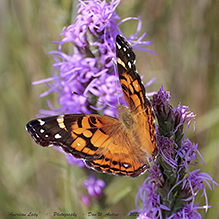 |
||||
Gerry Garcia |
|||||
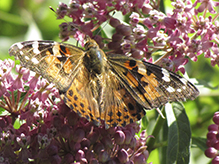 |
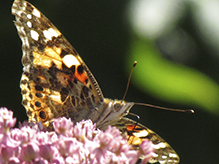 |
||||
 |
|||||
MinnesotaSeasons.com Photos |
|||||
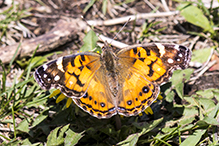 |
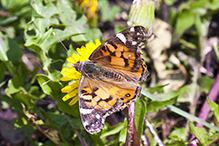 |
||||
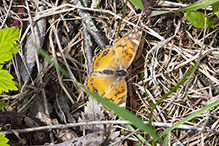 |
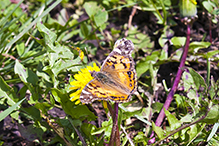 |
||||

Slideshows |
||
| American Lady (vanessa virginiensis) Andree Reno Sanborn |
||
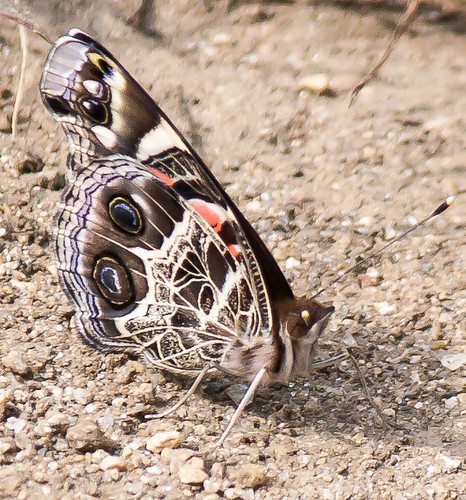
|
||
| vanessa virginiensis (American Lady) Allen Chartier |
||
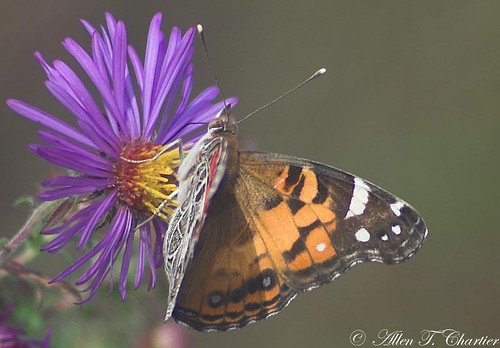
|
||
| American Lady Butterfly Andy Reago & Chrissy McClarren |
||
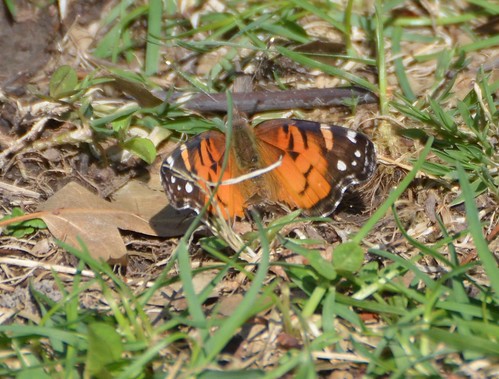
|
||
| American Lady jt893x |
||
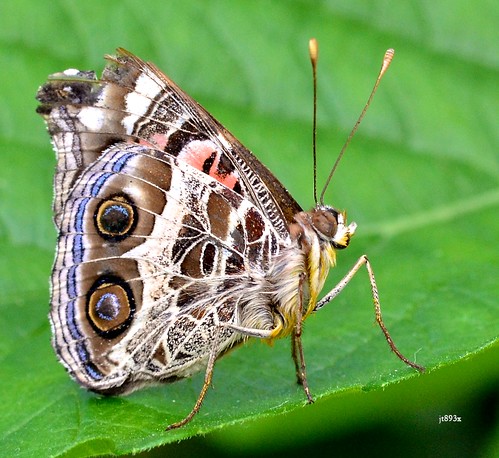
|
||

visitor videos |
|||
Share your video of this insect. |
|||
| This button not working for you? Simply email us at info@MinnesotaSeasons.com. Attach a video, a YouTube link, or a cloud storage link. |
|||
Gerry Garcia |
|||
| American lady 01 Published on Aug 5, 2019 |
|||
About
American lady (vanessa virginiensis) Lyndale Park, Minneapolis, MN video by Gerry Garcia http://www.minnesotaseasons.com/Insects/monarch.html |
|||
Other videos |
|||
| American Painted Lady - September 7, 2013 Don Gagnon |
|||
About
Published on Sep 11, 2013 American Lady (vanessa virginiensis), Mass Audubon Allens Pond, Westport, Massachusetts, Saturday afternoon, September 7, 2013, 1:20 PM - Canon PowerShot SX50 HS MvI_45680; 2:22 min. |
|||
| American Lady Caterpillar - September 14, 2013 Don Gagnon |
|||
About
Published on Sep 18, 2013 American Lady (vanessa virginiensis) Caterpillar, Returning to Webbed Nest on Thistle, Beach Loop Trail, Mass Audubon Allens Pond Wildlife Sanctuary, 1280 Horseneck Road, Westport, Massachusetts, Saturday morning, September 14, 2013, 11:27 AM - Canon PowerShot SX50 HS MvI_47527; 2:02 min. |
|||
| American Lady Butterfly Nectaring at Korean Daisies.MOv Kim Smith |
|||
About
Uploaded on Nov 19, 2009 An American Lady (vanessa virginiensis) butterfly nectaring at Korean Daisies, Noveber 2009, Gloucester, Massachusetts. |
|||


Last Updated:
